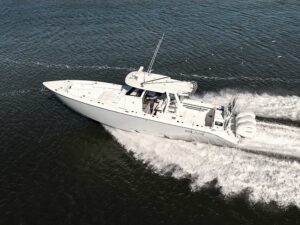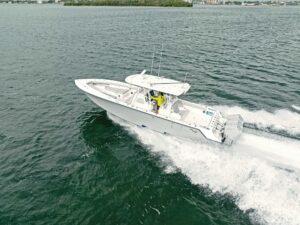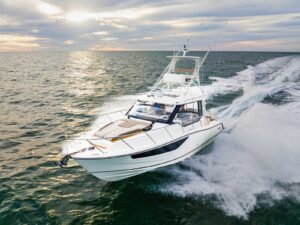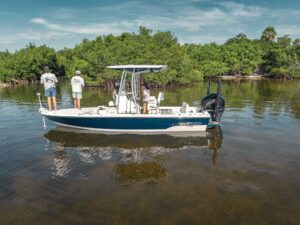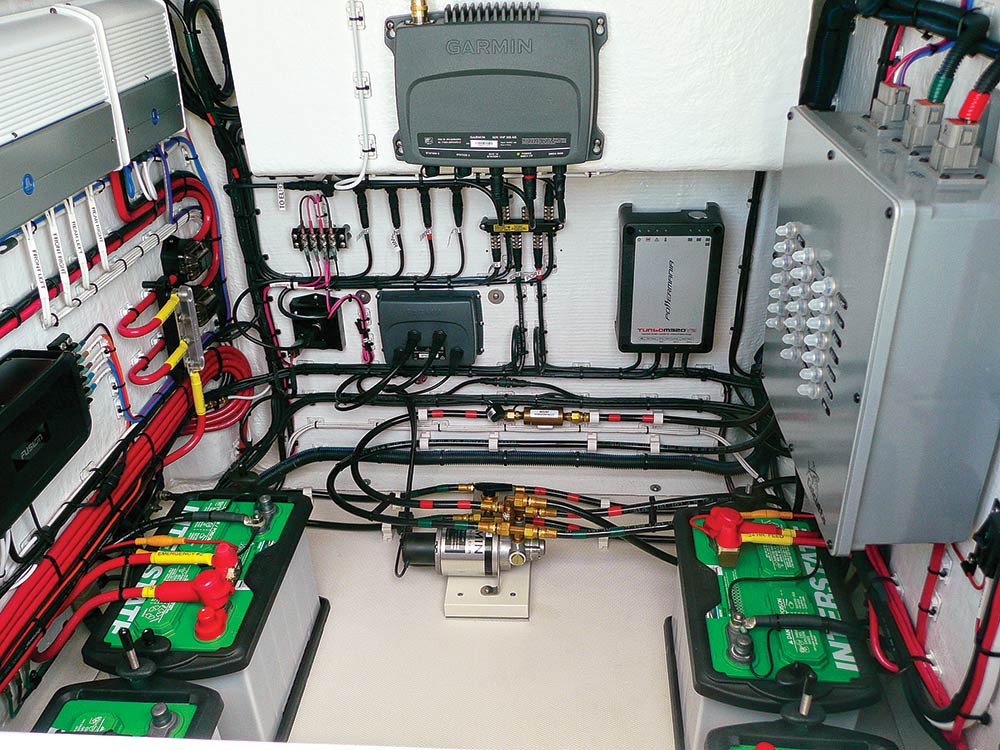
In the realm of digital outboards, trolling motors and amp-sensitive electronics, power is everything. We expect things to work, and when they don’t, not only could the trip be ruined, but you and your loved ones could also suddenly find yourselves in an uncomfortable or even risky situation.That’s why the right batteries and connections are so important.
There are three types of marine batteries: cranking, deep-cycle and dual-purpose. Each outboard should have a dedicated cranking battery, and the engine manual will list the cranking amps required for proper operation. Choose a battery that meets or exceeds that specified output to keep outboard computers and sensors happy.
Deep-cycle batteries, which release energy at a slower pace and can be discharged to lower levels for longer periods, are designed to power trolling motors and accessories, and made to handle hundreds of cycles over their life span. Reserve capacity, the time a battery can carry a load before recharging, is the key designation with this type.
Dual-purpose batteries offer both cranking power and some deep-cycle capability, but provide neither the starting jolt of a dedicated cranking battery nor the prolonged reserve power of a deep-cycle type. If space is tight, they serve the purpose. But separate, dedicated cranking and deep-cycle batteries (or system batteries for electronics, livewell pumps and other components) are the best setup.
Batteries are also distinguished by the charging materials used in construction. Wet cell — or flooded lead-acid plates — is the most common. They are the least expensive and last several seasons if properly maintained. AGM (absorbent glass matting) batteries use matting soaked with acid electrolyte between the plates for internal replenishment. They are maintenance-free, can be mounted at any angle, don’t require venting of hazardous gases, and have a low self- discharge rate. AGM batteries, however, are heavy and cost considerably more than their lead-acid counterparts. Gel batteries, priced comparably to AGMs, use a liquid gel that provides a low self-discharge rate and resists vibration and overcharging.
Lithium batteries, the latest entry in the marine market, offer several advantages, albeit with steep price tags. The lithium produces more cranking power, faster recharging times, and weighs substantially less. Such batteries are also extremely efficient, long-lasting and maintenance-free. Their size is often larger, however, requiring more space, and prices for a 12-volt cranking model run more than $1,500, yet it weighs only about 28 pounds.
“A cranking battery lasts up to six years, while trolling-motor batteries often last half that. But they all like a full charge. If you draw them down all the way, they’re never the same again.”
Peter Wright Jr. of the Ship’s Chandler
With so many options, battery selection usually comes down to application, budget and specific boat requirements, but I turned to some experts for advice. “Most of our customers don’t really know which batteries they want or need,” explains Peter Wright Jr. of the Ship’s Chandler, a dealer in Destin, Florida, for Pathfinder, Maverick, Hewes, Blackjack, Frontier and Jupiter boats. Wright says most of the batteries they install are Interstate lead-acid and Optima gel batteries, although they have added some lithium models. “We make recommendations and always try to use the best battery for the application. But the footprint is very important. If possible, we like to group all the batteries inside the console so everything is protected. We can get three Optima Group 34 batteries inside the console of an 18-foot Maverick, or up to five on a 26-foot Pathfinder. That frees up space in other compartments for storage, keeps the electrical system out of the elements, and maintains the center of gravity near midship.
“The trend is definitely going toward maintenance-free models,” he explains. “A cranking battery lasts up to six years, while trolling-motor batteries often last half that. But they all like a full charge. If you draw them down all the way, they’re never the same again.” Wright stresses that maintaining batteries increases their longevity, and he recommends using 2- or 4-gauge wire for cranking battery connections, and 6-gauge for trolling motors.
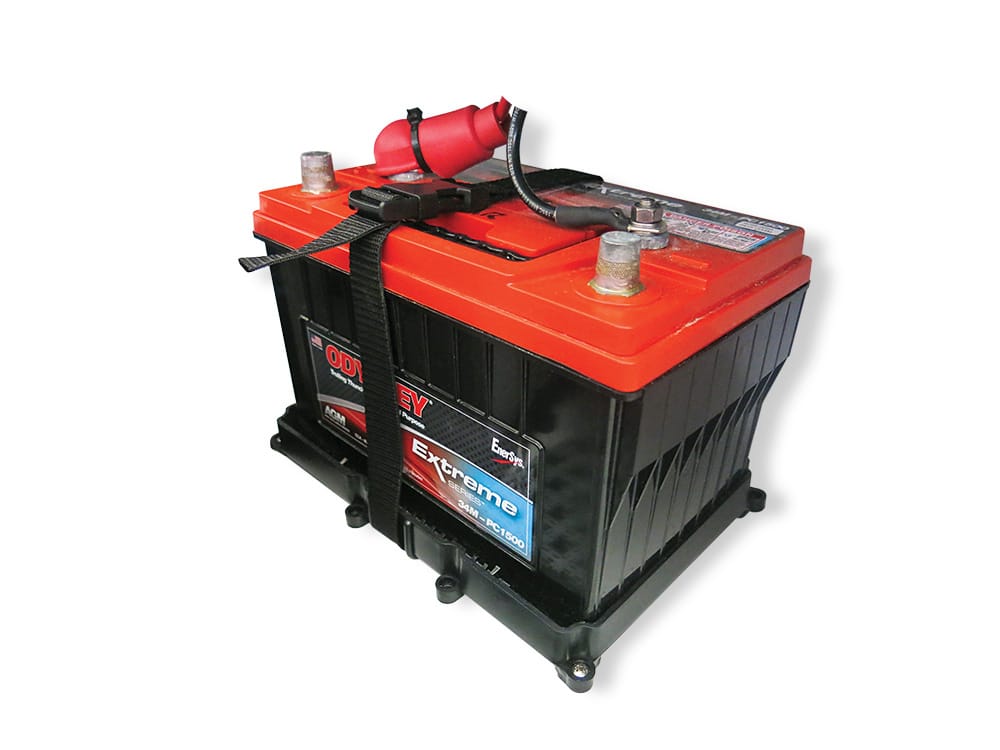
Wright adds that they have installed a few lithium batteries in the bows of skiffs to balance the load. “They are great as far as weight, but the actual size sometimes limits where they can be installed.”
Lighter weight, longevity, high output, and replacement versatility are the qualities that set the lithium-ion batteries apart, says Jeff Mull with Lithium Pros, a maker of marine batteries that has used lithium iron phosphate for the past six years, the chemically safest and same type used in Tesla electric cars.
“Our batteries are 96 percent efficient at converting energy, and they deliver more cranking power for faster starts,” Mull explains. “They also recharge faster and last up to 2,500 cycles. So these are eight- to 10-year batteries.” Lithium Pros offers a full four-year warranty and has a growing number of saltwater customers. Lithium’s lighter weight can impact draft and balance, plus the power options reduce the number of batteries required in some applications.
“One of our 36-volt M3140 batteries, which weighs 27 pounds, does the same as three Group 27 12-volt batteries weighing 75 pounds each,” Mull says. “We have professional anglers who had to replace trolling-motor batteries every year. Now those same guys are on their fifth year with ours producing the same energy output.”
Dependable power is a critical need for today’s sport-fishing boats. Choose the right batteries, install and maintain them properly, and you’ll keep the juice flowing for years. Then you’ll always have power when you need it most — when you go fishing.
Battery Checklist for Anglers
1.) Keep batteries fully charged to prolong their life.
2.) Secure batteries in dedicated boxes, or fasten with straps or plates, to avoid damage from jostling in a chop.
3.) Never use wing nuts to secure battery cables to the terminals; use stainless-steel nuts with lock washers instead.
4.) Carry the appropriate wrench or socket on board to tighten loose cables or disconnect a battery on the water.
5.) Unless batteries are maintenance-free, check water levels routinely.
6.) Store batteries in climate-controlled spaces to prevent damage.
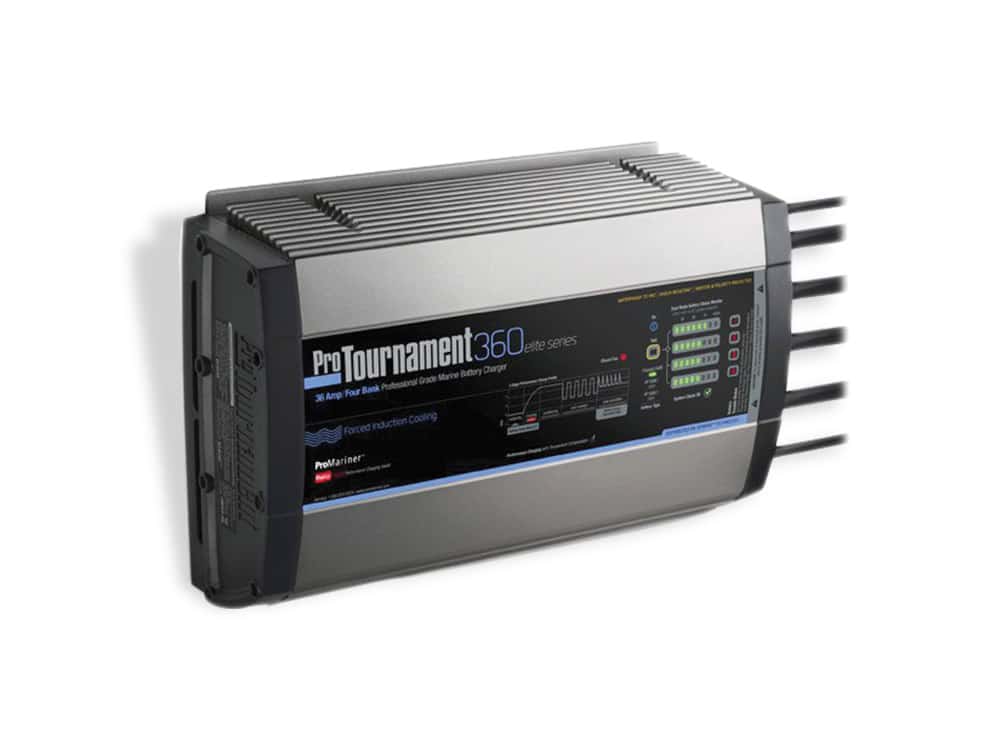
Battery Chargers
Marinco, Optima, West Marine and NOCO are popular brands of portable marine chargers. Most still incorporate alligator clamps, but many are shock- and waterproof, automatic, feature overload and polarity protection, and spark-free hook-up. They, however, require you to individually charge every battery.
Smart chargers can tell the difference between battery types, but others require manual settings for gel, lead-acid, and AGM batteries. AGMs require different voltages, but if a charger lacks the AGM setting, use the lead-acid setting.Promariner, Marinco, Dual Pro, Minn Kota and others offer fully automatic, three-stage onboard chargers that are vibration-, shock- and waterproof, and designed to distinguish between Wet Cell, AGM and gel batteries to recharge and maintain them at the proper voltage. You’ll pay two to four times the cost of a portable charger for top plug-it-and-forget-it models with two-, three- and four-bank configurations, which afford you the time savings and convenience of charging multiple batteries at once.

